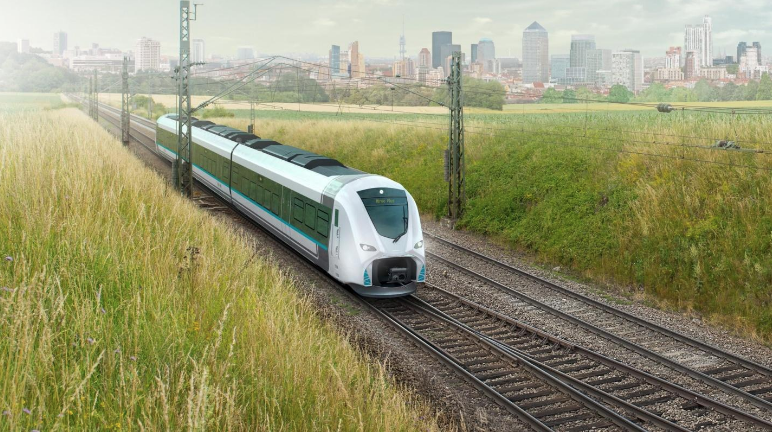Here at Ballard, we are always inspired by the growing number of industries that are shifting to zero-emission solutions. And when it comes to hydrail, Siemens is a world leader in the development and deployment of this technology.
We had the good fortune to speak with Jochen Steinbauer, Director of Platform and Business Development for alternative drive systems for regional trains at Siemens. Jochen shares his views hydrogen train technology as a solution for rail applications.
Interview with Siemens’ Jochen Steinbauer on Innovations in Fuel Cell Train Technology
Can you tell us a bit about your background? 
In 2003, I started my career at Siemens in the rail electrification department. I did the initial work on power supply networks, and after a couple years I moved into R&D.
I was then responsible for the new development of DC protection units and after that, I took on a sales role for a complete worldwide turnkey rail project, focusing on the Middle East and Asia. I was asked to take over the project management lead for a project in Qatar.
This was Siemens' first project with trains running without a catenary system, equipped with energy storage onboard. These trains had a combination of batteries and ultracapacitors. Finally, five years later, I took over the lead for the hybridization of regional trains, including the development of battery trains and, of course, fuel cell trains. And this is what I've done since March 2017.
Why do you think hydrogen is a good solution for rail applications?
Hydrogen technology is not only a good solution for rail applications, but for a variety of energy sectors. Looking at the current view of climate change and energy production worldwide, hydrogen is the appropriate storage medium for almost everything. The key is to be able to store the energy, which is generated at a time when there is low consumer demand making it available. To introduce it into the market, the heavy-duty applications need to come first because they have a lot of power requirements and a lot of consumption of the necessary fuel. Therefore, it makes sense to install the corresponding infrastructure. If the infrastructure for the heavy duty applications is available, then cars and light duty transportation vehicles will follow. It's our approach to provide a filling station not only for the heavy duty applications, such as trains, but also for the cars. Then we have a good combination that serves the needs of both.
 On a global level we're seeing a policy shift towards zero-emission transportation technologies. What type of political or financial environment needs to be in place for communities adopt the technology and transition to a hydrogen energy solution?
On a global level we're seeing a policy shift towards zero-emission transportation technologies. What type of political or financial environment needs to be in place for communities adopt the technology and transition to a hydrogen energy solution?
There must be a solid business case for the application of hydrogen, especially for rail. Whenever the business case is positive, our clients view it as a viable alternative to the current model. The price of hydrogen has a major influence on the financial viability and adoption of this zero-emission solution. It’s this environment that politicians need to control, and provide the subsidies to make hydrogen cost competitive. This will be the tipping point to encourage wider market adoption and help bring heavy-duty applications into the market.
(Related Post: How Policy Makers Can Drive Us to a Zero-Emission Future)
What are the current market opportunities for hydrogen trains?
You can't even imagine. This market is so huge, especially in Germany. Every month a new tender is released for alternative power supply for regional trains. The interesting thing is whenever you look into these tenders, we as rail suppliers have to completely change our mind. Clients do not require only the vehicle and the service but also the infrastructure, and of course the hydrogen - the complete chain of power generation. And of course this is an opportunity which Siemens can bring to the clients because we are in a position to provide the client everything from the wind power to the electrolyzer to train of service.(Related Post: High-Tech Hydrogen Trains Are Revolutionizing Mass Transit)

Siemens Mireo Hydrogen Regional Train
Is Siemens looking at this as a vertically integrated solution: from providing the wind generating solutions, the hydrogen electrolyzers, a storage transportation network, on-site storage of hydrogen and then the systems that will propel the train? Is this the business model Siemens is going for, or are you partnering with any other companies?
We’re providing a vertically integrated solution with a few key partners. The only elements we cannot provide our clients are the hydrogen filling station and the fuel cell technology. There are lots of possibilities to offer wind power or power distribution, generation, hydrogen generation via electrolyzers. This is a value-add Siemens can deliver to our clients and the market.
Which jurisdictions have the best opportunity to move this forward, create this technology and hopefully drive the cost down?
First of all, from a global perspective, the U.K. is the most advanced with respect to hydrogen technology deployment. They have proclaimed that no diesel cars can enter certain cities. Plus they already announced that diesel powered vehicles will be completely prohibited by 2040, including trains. They are very well advanced in terms of the political environment and regulation. From the power generation perspective, I think Germany and Scandinavian countries have a very good opportunity because they have the offshore wind power installations in the North Sea. This is a great opportunity and this is exactly where Siemens is jumping up because our story is to provide the complete chain: from zero-emission power generation, hydrogen production and delivery to the consumer.
That's the reason why we’re working with Ballard; a top to bottom solution. With fuel cells required for rail and heavy duty applications, we needed to partner with a successful company. They really fulfilled the client requirements in terms of lifetime, power density, and efficiency. That's the reason Siemens decided we need a high performing electrical train, with a new generation of fuel cells, with the higher efficiency rate, power density and life duration. High performing electrical vehicles together with a new generation of fuel cells, can bring some real value-add to the market and to the client.
What are what are some of the challenges you’re encountering to get that technology adopted?
First of all, in a lot of people's minds there is still a safety issue when they think of hydrogen. Second, our clients have to rethink their operations. They have to deal with completely new requirements and the onboard maintenance needs. All of these issues they've never dealt with before. On the other hand, they have new opportunities by introducing hydrogen train technology. Currently, whenever people have to commute from the suburbs into the inner city, they have to change the train they are riding. Very often they start their day on a diesel powered train in a very small city and ride to a certain station. Then they have to change trains because electrification will start on a different line. With a fuel cell battery train they can run completely from the the outer city into the inner city without changing trains. It saves money and time.
Can you tell us a little bit more about the current Siemens hydrogen train project, what is the next milestone, and how has your progress been so far?
We started with this project officially in October last year because it's funded from the German Ministry of Transport together with University of Aachen. Siemens created something new, optimizing an overall system and a vehicle based on an electrical train. Together with Ballard, we now have the first specifications in place for the next generation of fuel cells. We have already defined our unique selling point very accurately. We're going to see this next generation of fuel cells running in autumn this year in Vancouver. This is the first part of the introduction system testing.
(Related Post: Hydrail: The World Is Ready and New Progress Proves It)
What is your long-term vision for hydrogen rail mobility?
I think in the next five years battery trains might prevail in markets. But because batteries do have some really huge disadvantages, I believe in five-to-eight years, hydrogen trains might overtake battery trains. Hydrogen has a lot of advantages regarding weight and torque function, independence and flexibility. I also think that the market needs some prototypes, which will help open the eyes and minds of the people and let them see that hydrogen is not dangerous, runs perfectly and that it can save a lot of money. We need to do this in three years while also concentrating on building the first hydrogen train.
Do you have any other comments say you'd like to share?
Hydrogen trains are primarily developed for replacing diesel trains, but you have to bring some value-add to the client and to the market. This is exactly what Siemens is doing. We are providing some great advantages from an optimized system and a good partnership with Ballard. When we complete our development of the next generation of fuel cells, this can really add value to the complete hydrogen market.Next Step:
Download the presentation below to learn how Ballard is adapting its leading fuel cell technologies to various rail applications around the world.




